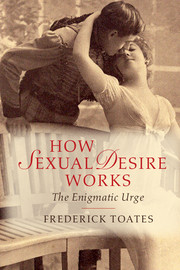Book contents
- Frontmatter
- Dedication
- Contents
- List of figures
- Preface
- One What is enigmatic about sexual desire?
- Two Explaining desire: multiple perspectives
- Three Sexual desire in a broad context
- Four An incentive-based model
- Five Sex and levels of organization
- Six Sexual attraction
- Seven Shades of desire from simple to complex
- Eight Details of the brain and desire
- Nine Arousal
- Ten The consequences of sexual behaviour and associated expectations
- Eleven Sexual familiarity and novelty
- Twelve Inhibition, conflict and temptation
- Thirteen How did sexual desire get here?
- Fourteen Setting the trajectory: link to adult sexuality
- Fifteen Sexual desire in interaction
- Sixteen Representations of sex
- Seventeen Sexual addiction
- Eighteen Variations in desire: general principles
- Nineteen Some forms of desire at the fringes
- Twenty The toxic fusion: violence and sexual desire
- Twenty one Sexually associated (serial) murder
- Twenty two Concluding remarks
- Notes
- References
- Index
Twelve - Inhibition, conflict and temptation
Published online by Cambridge University Press: 05 October 2014
- Frontmatter
- Dedication
- Contents
- List of figures
- Preface
- One What is enigmatic about sexual desire?
- Two Explaining desire: multiple perspectives
- Three Sexual desire in a broad context
- Four An incentive-based model
- Five Sex and levels of organization
- Six Sexual attraction
- Seven Shades of desire from simple to complex
- Eight Details of the brain and desire
- Nine Arousal
- Ten The consequences of sexual behaviour and associated expectations
- Eleven Sexual familiarity and novelty
- Twelve Inhibition, conflict and temptation
- Thirteen How did sexual desire get here?
- Fourteen Setting the trajectory: link to adult sexuality
- Fifteen Sexual desire in interaction
- Sixteen Representations of sex
- Seventeen Sexual addiction
- Eighteen Variations in desire: general principles
- Nineteen Some forms of desire at the fringes
- Twenty The toxic fusion: violence and sexual desire
- Twenty one Sexually associated (serial) murder
- Twenty two Concluding remarks
- Notes
- References
- Index
Summary
But I see another law in my members, warring against the law of my mind, and bringing me into captivity to the law of sin which is in my members.
(St Paul’s Epistle to the Romans 7: 23)The nature of inhibition
The means by which desire is inhibited (‘restrained’) represent an important feature of ‘how desire works’ and will be explored here. St Paul describes one form of conflict: that between the will and desire. Throughout the ages, prohibitions and disapproval of ‘inappropriate desire’ and its expression seem as evident as desire itself.
Social harmony requires that all societies have curbs on sexual behaviour, whether of an aesthetic, legal, cultural, religious or moral nature. Some potential inhibitors of sexual desire, such as public censure, have eased with more relaxed attitudes. However, jealousy, anger and disgust over what are judged to be unacceptable desires in others are still universal. For some, the existence of desire and its inhibition represent proverbial conflict.
- Type
- Chapter
- Information
- How Sexual Desire WorksThe Enigmatic Urge, pp. 199 - 228Publisher: Cambridge University PressPrint publication year: 2014

